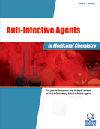- Home
- A-Z Publications
- Anti-Infective Agents in Medicinal Chemistry (Formerly Current Medicinal Chemistry - Anti-Infective Agents)
- Previous Issues
- Volume 8, Issue 1, 2009
Anti-Infective Agents in Medicinal Chemistry (Formerly Current Medicinal Chemistry - Anti-Infective Agents) - Volume 8, Issue 1, 2009
Volume 8, Issue 1, 2009
-
-
Editorial
More LessAntibiotic discovery and development have undergone major changes in the new millennium, namely changes in the molecular chemotypes that are being examined as new anti-infectives and in regimens of treatment. Chemical structures that were of minor scientific interest years ago, now have more research devoted to them by diligent and determined researchers throughout the world- and this is happening for a number Read More
-
-
-
Polyfunctional Antibiotics Affecting Bacterial Membrane Dynamics
More LessAuthors: Mark L. Nelson, Mark C. Grier, Susan E. Barbaro and Mohamed Y. IsmailThe β-lactam family of antibiotics, the penicillins and cephalosporins, act primarily at the level of the bacterial membrane by inhibiting membrane proteins associated with cell wall synthesis. As a family they represent some of the most clinically relevant antibiotics known, although antibiotic resistance has limited the use of older generation β-lactams, novel compounds are currently emerging from research efforts worldwide. Read More
-
-
-
Interaction of Melittin with Phospholipid- and Lipopolysaccharide- Containing Model Membranes
More LessUp to now the details of the mechanisms of melittin action on biological bilayer model systems in dependence on lipid composition, in particular on the kind of head groups, temperature, and ionic strength are not well understood. In particular, the influence of cholesterol present in most eucaryotic cells and the influence of glycolipids present in bacterial membranes are far from being clear. Here, data are presented from Read More
-
-
-
β-Lactams as Neuroprotective Agents
More LessAuthors: Monika I. Konaklieva, Balbina J. Plotkin and Terena HerbertAlthough, β-lactams have historically been viewed as a class of antimicrobials, in the last few decades their role as inhibitors of bacterial enzymes has been expanded. Their inhibitory activity is based on their ability to acylate enzymes, majority of which have serine as nucleophile in the active site. In addition to being inhibitors of bacterial enzymes, β-lactams also inhibit viral and mammalian serine enzymes. Recently, a blinded Read More
-
-
-
Recent Trends in Plant-Derived Antifungal Agents
More LessAuthors: M. Shahid, A. Shahzad, T. Tripathi, F. Sobia, A. Sahai, A. Singh, A. Malik, F. Shujatullah and H. M. KhanRecent years have witnessed emergence of resistance to azoles and other antifungal compounds. Moreover, the existing antifungal compounds for the contemporary clinicians are limited in numbers as opposed to available antibacterial compounds. Hence there is a real need to search for newer compounds with potential antifungal activity. In this review, the potential of medicinal plant species to yield newer antifungal agen Read More
-
-
-
Dendritic Compounds as Immune Response Modulators. New Approaches for Vaccine Development
More LessBy Javier RojoDespite several infectious diseases which have been eradicated or controlled worldwide nowadays, there are still some infectious diseases such as AIDS, caused by HIV, which are supposed to be a serious social health problem and demand the search for new vaccines. A classical approach for generation of vaccines against infection was initially based on the use of killed or attenuated pathogens. With the increase of informatio Read More
-
-
-
The Use of Structure-Guided Design to Discover New Anti-Microbial Agents: Focus on Antibacterial Resistance
More LessAuthors: P. S. Charifson, T. H. Grossman and P. MuellerSerious attempts to address antibiotic resistance, a worldwide public health concern, have recently become more intensive. In hospital settings, resistance to antibacterial agents has been recognized by clinicians for several decades. Resistant strains are now isolated on a daily basis from patients with community-acquired infections further elevating the level of concern among public health officials. The pharmaceutical ind Read More
-
Most Read This Month
Article
content/journals/aiamc
Journal
10
5
false
en


